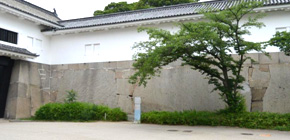
Two huge square-shaped stones at Osaka Castle Ote-mon Gate found to have been a single large stone
A step toward the clarification of stone wall building methods and quarries
A group of researchers led by Professor SATO Kosuke and Master Course Student MORITA Karin (Graduate School of Engineering Science, Osaka University) and MIKANE Yuji (Kanagawa Archaeology Foundation) developed an automatic joint method for obtaining a fine-tuned integrated whole by matching surface contours of two stones after roughly coordinating two stones through 3D alignment of wedge quarry holes. By using this method, this group succeeded in measuring the huge stones used for the square-shaped stone at the Ote-mon gate and precisely matching the two huge stones in a virtual-reality space. By doing so, this group sterically verified that the Ote-mitsuke stone and the Ote-niban stone were originally a single stone but later were divided into two by using wedge quarry holes.
This group also developed an automatic joint method for recovering an original stone by combining two split stones in a virtual reality space, even though they are fit into a stone wall, to retrieve the original stone using 3D measurements with a digital camera. Using this technique, this group clarified parts whose surface was chipped and parts recently detached.
Traces of wedge quarry holes still remain in most stone materials built into stone walls at historical sites such as castles. This automatic joint method will lead to the development of artificial intelligence for archaeology capable of discovering pairs of split stones and will clarify stone wall building methods and quarries.
The results of this study were presented at the 36 th Conference of the Japan Society for Archaeological Information held at Kyushu National Museum on March 26 and March 27, 2016.


Figure 1

Figure 2

Figure 3

Figure 4

Figure 5
Related link
